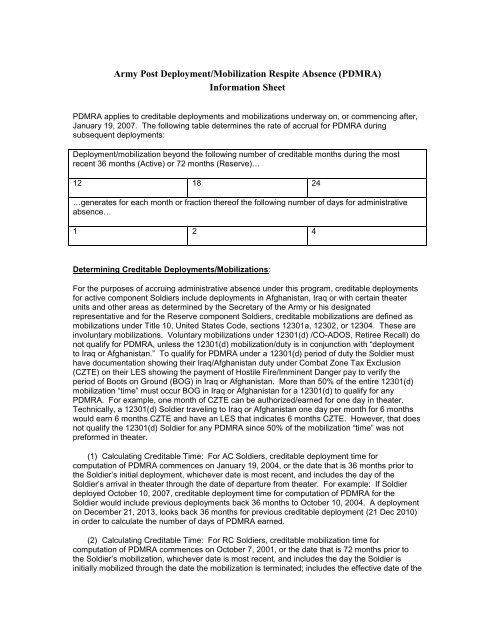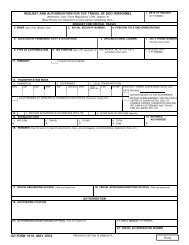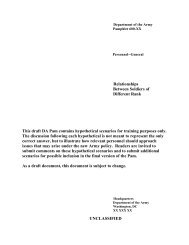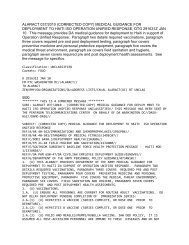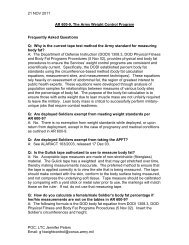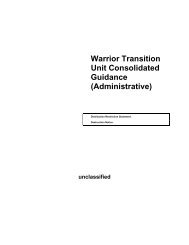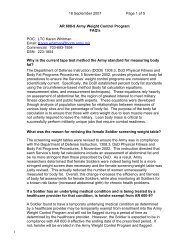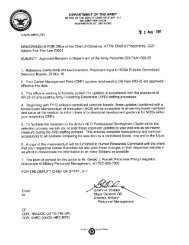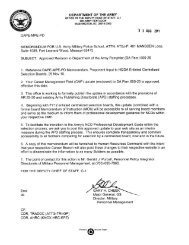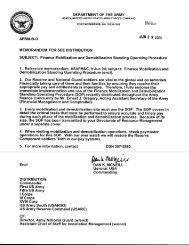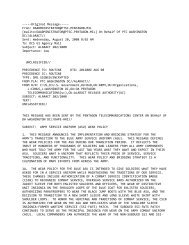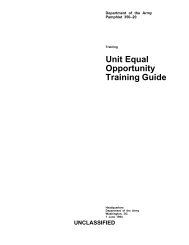Army Post Deployment/Mobilization Respite Absence (PDMRA ...
Army Post Deployment/Mobilization Respite Absence (PDMRA ...
Army Post Deployment/Mobilization Respite Absence (PDMRA ...
You also want an ePaper? Increase the reach of your titles
YUMPU automatically turns print PDFs into web optimized ePapers that Google loves.
<strong>Army</strong> <strong>Post</strong> <strong>Deployment</strong>/<strong>Mobilization</strong> <strong>Respite</strong> <strong>Absence</strong> (<strong>PDMRA</strong>)<br />
Information Sheet<br />
<strong>PDMRA</strong> applies to creditable deployments and mobilizations underway on, or commencing after,<br />
January 19, 2007. The following table determines the rate of accrual for <strong>PDMRA</strong> during<br />
subsequent deployments:<br />
<strong>Deployment</strong>/mobilization beyond the following number of creditable months during the most<br />
recent 36 months (Active) or 72 months (Reserve)…<br />
12 18 24<br />
…generates for each month or fraction thereof the following number of days for administrative<br />
absence…<br />
1 2 4<br />
Determining Creditable <strong>Deployment</strong>s/<strong>Mobilization</strong>s:<br />
For the purposes of accruing administrative absence under this program, creditable deployments<br />
for active component Soldiers include deployments in Afghanistan, Iraq or with certain theater<br />
units and other areas as determined by the Secretary of the <strong>Army</strong> or his designated<br />
representative and for the Reserve component Soldiers, creditable mobilizations are defined as<br />
mobilizations under Title 10, United States Code, sections 12301a, 12302, or 12304. These are<br />
involuntary mobilizations. Voluntary mobilizations under 12301(d) /CO-ADOS, Retiree Recall) do<br />
not qualify for <strong>PDMRA</strong>, unless the 12301(d) mobilization/duty is in conjunction with “deployment<br />
to Iraq or Afghanistan.” To qualify for <strong>PDMRA</strong> under a 12301(d) period of duty the Soldier must<br />
have documentation showing their Iraq/Afghanistan duty under Combat Zone Tax Exclusion<br />
(CZTE) on their LES showing the payment of Hostile Fire/Imminent Danger pay to verify the<br />
period of Boots on Ground (BOG) in Iraq or Afghanistan. More than 50% of the entire 12301(d)<br />
mobilization “time” must occur BOG in Iraq or Afghanistan for a 12301(d) to qualify for any<br />
<strong>PDMRA</strong>. For example, one month of CZTE can be authorized/earned for one day in theater.<br />
Technically, a 12301(d) Soldier traveling to Iraq or Afghanistan one day per month for 6 months<br />
would earn 6 months CZTE and have an LES that indicates 6 months CZTE. However, that does<br />
not qualify the 12301(d) Soldier for any <strong>PDMRA</strong> since 50% of the mobilization “time” was not<br />
preformed in theater.<br />
(1) Calculating Creditable Time: For AC Soldiers, creditable deployment time for<br />
computation of <strong>PDMRA</strong> commences on January 19, 2004, or the date that is 36 months prior to<br />
the Soldier’s initial deployment, whichever date is most recent, and includes the day of the<br />
Soldier’s arrival in theater through the date of departure from theater. For example: If Soldier<br />
deployed October 10, 2007, creditable deployment time for computation of <strong>PDMRA</strong> for the<br />
Soldier would include previous deployments back 36 months to October 10, 2004. A deployment<br />
on December 21, 2013, looks back 36 months for previous creditable deployment (21 Dec 2010)<br />
in order to calculate the number of days of <strong>PDMRA</strong> earned.<br />
(2) Calculating Creditable Time: For RC Soldiers, creditable mobilization time for<br />
computation of <strong>PDMRA</strong> commences on October 7, 2001, or the date that is 72 months prior to<br />
the Soldier’s mobilization, whichever date is most recent, and includes the day the Soldier is<br />
initially mobilized through the date the mobilization is terminated; includes the effective date of the
Soldier’s mobilization orders through the date of the expiration of the mobilization order, to<br />
include periods of R&R and temporary duty (TDY) outside Iraq and Afghanistan for TDY periods<br />
of 30 days or less. For example: A deployment on December 21, 2013, looks back 72 months for<br />
previous creditable deployment(s)…December 21, 2007 in order to calculate the number of days<br />
of <strong>PDMRA</strong> earned. <strong>PDMRA</strong> accrual for RC Soldiers includes all qualifying mobilizations, not just<br />
to Iraq or Afghanistan. Only mobilizations under 12301(a), 12302, or 12304 qualify to accrue<br />
<strong>PDMRA</strong>. A 12301(d) period of duty also qualifies for accrual of <strong>PDMRA</strong> when it is documented<br />
that the 12301(d) period was in conjunction with a deployment in support of Contingency<br />
Operations in Iraq or Afghanistan; deployment time for this purpose includes the day of the<br />
Soldier’s arrival on Title 10 at MOB station through his REFRAD date. <strong>PDMRA</strong> days do not<br />
continue to accrue while Soldier is on transition leave and/or extension of mobilization orders for<br />
the purpose of <strong>PDMRA</strong> usage.<br />
(3) Examples: The following examples illustrates calculation methodology for accrual of<br />
<strong>PDMRA</strong> days for both active component and reserve component Soldiers. Due to complicated<br />
calculations required, a basic <strong>PDMRA</strong> calculator has been developed to provide Commanders<br />
with a tool to determine the days of <strong>PDMRA</strong> earned by Soldiers. To access the calculator please<br />
use the following links: <strong>PDMRA</strong> Calculator and <strong>PDMRA</strong> Calculator Instructions.<br />
(a) Active Component:<br />
1. Scenario 1: An active component Soldier completes a 12 month deployment to Iraq or<br />
Afghanistan in 30 January 2006. He returns to his PDS where he expects to remain for at least<br />
two years. However, due to <strong>Army</strong> operation requirements he must again be deployed to<br />
theater/Iraq one year later in February 2007 for a 12 month deployment, thus breaking the<br />
established <strong>Army</strong> active component rotation policy goal of one year deployed and two years<br />
stabilized at home station/PDS. Calculation: The Soldier will begin to accrue <strong>PDMRA</strong> days in<br />
increments of 1-day per month for the first six months of the early redeployment, increasing to 2days<br />
per month on the seventh month and continuing at that rate till the end of the 12 month<br />
deployment and return to home station/PDS. In this case the Soldier would earn a total of 18days<br />
<strong>PDMRA</strong> (6-days for the first six months of deployment, and 12-days for the second six<br />
months of deployment) during the 12-month early deployment.<br />
2. Scenario 2: Member serves a 10 month deployment in Iraq from 15 January 2006 to 1<br />
October 2006 and returns to his home station/PDS. Member is scheduled for second deployment<br />
to theater/Iraq for 12 months beginning in May 2007, which breaks established rotation policy<br />
(1:2). Calculation: Soldier will begin to accrue <strong>PDMRA</strong> days in increments of 1-day per month on<br />
the third month of the second deployment to theater/Iraq and continuing at that rate for the first<br />
six months of the second deployment, increasing to 2-days per month on the seventh month and<br />
continuing at that rate till the end of the 12 month deployment and return to home station/PDS. In<br />
this case the Soldier would earn a total of 14-days <strong>PDMRA</strong> (6-days for month 3 to 8 of the<br />
second deployment, and 8-days for the last 4 months of second deployment) during the 12-month<br />
of the second deployment.<br />
3. Scenario 3: Member serves 15 months assignment in Qatar from 1 February 2005 to 10<br />
April 2006, followed by an immediate 12-month deployment to Afghanistan. Calculation: Qatar<br />
was not designated as a qualifying <strong>PDMRA</strong> area by the Secretary of the <strong>Army</strong>. Consequently, it<br />
is not a creditable deployment location under current guidelines, and, therefore, does not entitle<br />
the member to any creditable <strong>PDMRA</strong> time.<br />
4. Scenario 4: More complicated situation and calculation. Soldier serves a 12 month<br />
deployment in Iraq from April 2005 to March 2006 and returns to his home station/PDS. Nine<br />
months late Soldier again deployed to theater/Iraq, January-December 2007 for 12-months.<br />
During the second deployment Soldier would earn 18-days of <strong>PDMRA</strong>. However, 8-months later<br />
(September 2008) the Soldier is again deployed to theater/Iraq for 15 months (September 2008-<br />
November 2009, which again breaks the established DoD 1:2 year rotation policy making him
eligible for <strong>PDMRA</strong>. Calculation: Soldier earned 18-days <strong>PDMRA</strong> during the first qualifying 12month<br />
deployment (January-December 2007) after crediting the “time” for the 12 month<br />
deployment for April 2005 to March 2006. The second qualifying 15-month deployment<br />
(September 2008-November 2009) is a more complicated calculation, but would earn the Soldier<br />
36-days <strong>PDMRA</strong> after factoring in the qualifying 2007 deployment and last 6-months of<br />
deployment in 2005/06. This calculation requires counting back 36 months from the deployment<br />
date of September 2008, per DoD guidance. This starts 36 month qualifying creditable “time”<br />
window on September 2005. Counting forward “only” the months of deployment and factoring in<br />
the “rolling window” of eligibility indicates that on redeployment (September 2008) the Soldier will<br />
have 20 qualifying months of deployment and would immediately begin to accrue 2-days <strong>PDMRA</strong><br />
per month. However, on the 6 th month of the Soldier’s deployment (February 2009), where you<br />
would assume the Soldier will begin to accrue 4-days of <strong>PDMRA</strong> per month for the remainder of<br />
the 15-months deployment, the Soldier continues to accrue 2-days per month due to the “rolling<br />
window” of eligibility until deployment month 12. For the last three months of deployment the<br />
Soldier would earn 4-days <strong>PDMRA</strong>, which would earn the Soldier at total of 36-days of <strong>PDMRA</strong><br />
during the 15 month deployment. <strong>Deployment</strong> table 1 below depicts the deployment periods<br />
(red), dwell breaks (green) and days earned (white numerals).<br />
2003 2004 2005 2006<br />
O N D J F M A M J J A S O N D J F M A M J J A S O N D J F M A M J J A S O N D<br />
J F M A M J J A S O N D J F M A M J J A S O N D J F M A M J J A S O N D<br />
1 1 1 1 1 1 2 2 2 2 2 2 2 2 2 2 2 2 2 2 2 2 2 2 4 4 4<br />
(<strong>Deployment</strong> table 1)<br />
(b) Reserve Component:<br />
2007 2008 2009<br />
1. Scenario 1: A Reserve component Soldier completes a one year deployment to Iraq or<br />
Afghanistan, under the authority of 10 USC 12302. He returns to his home station/PDS, where<br />
he expects to remain for at least 5-years, but due to <strong>Army</strong> operation requirements he must be<br />
deployed to theater 4-years later, thus breaking the established <strong>Army</strong> RC rotation policy goal of<br />
one year mobilization and five years stabilized at home station/PDS. Calculation: The Soldier will<br />
begin to accrue <strong>PDMRA</strong> days in increments of 1-day per month for the first six months of the<br />
second mobilization/deployment, increasing to 2-days per month for the remaining 6 months of<br />
the second mobilization/deployment. In this example the Soldier would earn a total of 18-days<br />
<strong>PDMRA</strong> (6-days for the first six months of mobilization/deployment and 12-days for the second<br />
six months of second mobilization/deployment) during the 12-month mobilization/deployment.<br />
2. Scenario 2: An RC Soldier is mobilized on 15 October 2002 for 15 months, (under the<br />
authority of 10 USC 12302). Soldier mobilized a second time on 1 October 2006 (under the<br />
authority of 10 USC 12302), for a 12 month period expiring 30 September 2007. Calculation:<br />
First mobilization accrued 15 months of creditable time since it occurred within 72 months of the<br />
Soldier’s current mobilization. The second mobilization/deployment exceeded the established<br />
Reserve component rotation policy (1:5). During the second mobilization/deployment, the Soldier<br />
accrues one day of <strong>PDMRA</strong> for the first, 3 months (months-16, 17, 18). On the forth month of<br />
mobilization/deployment (month 19) through the ninth month (month-24) the Soldier accrues two<br />
days per month, because he or she has exceeded 18 months of creditable time. During the last 3<br />
months of the mobilization/deployment the Soldier earns 4-days <strong>PDMRA</strong> per month since he<br />
exceeded the 24 month mobilization/deployment threshold. In this scenario the Soldier would<br />
earn a total of 27-days <strong>PDMRA</strong> (2-days for the first 3 months of mobilization/deployment, and 12days<br />
for the months 4 through 9 and 12-days for last 3 months of the 12-month<br />
mobilization/deployment.
3. Scenario 3: Member mobilized on 15 October 2002 (under the authority of 10 USC<br />
12302) for 12 months. The member’s mobilization is extended for six months (still under 10 USC<br />
12302 authority) for a total of 18 months of mobilization. Member is mobilized/deployed a second<br />
time on 1 October 2006 (under 10 USC 12302 authority) for a 12 month period expiring 30<br />
September 2007. Calculation: The first mobilization accrued 18 months of creditable time since it<br />
occurred within 72 months of the member’s second mobilization. In the second<br />
mobilization/deployment, the Soldier begins to accrue <strong>PDMRA</strong> at the rate of 2-days per month for<br />
the first 6 months (months19-24). During months 6 through 12 (months 25-30) the Soldier will<br />
accrue <strong>PDMRA</strong> days at the rate of four days per month. In this scenario the Soldier would earn a<br />
total of 36-days <strong>PDMRA</strong> (2-days per month for the first 6 months of mobilization/deployment (12<br />
days), and 4-days per month (24 days) for the last 6 months of mobilization/deployment of the 12month<br />
mobilization/deployment<br />
4. Scenario 4: More complicated RC situation and calculation. Soldier serves a 16-month<br />
qualifying mobilization/deployment to Washington DC from January 2003 to April 2004 and<br />
returns to his home station/residence. Twenty-two months later Soldier remobilized/redeployed to<br />
CENTCOM for 12-months in March 2006 to February 2007, which breaks DoD established RC<br />
1:5 year rotation policy and would earn Soldier 30-days of <strong>PDMRA</strong> days. Per DoD guidance,<br />
<strong>PDMRA</strong> applies to creditable deployments and mobilizations “underway” or commencing after<br />
January 19, 2007. This mobilization/deployment would qualify for <strong>PDMRA</strong>, since it was<br />
“underway” after <strong>PDMRA</strong> program was implemented on January 19, 2007. Calculation: Soldier<br />
earns 30-days <strong>PDMRA</strong> for a qualifying 12-month mobilization/deployment (March 2006 to<br />
February 2007) after factoring in and crediting the qualifying 16-month mobilization “time”<br />
(January 2003 to April 2004) for mobilizations/deployments that commenced on October 7, 2001<br />
or a date that is 72 months prior to the Soldiers qualifying mobilization/deployment. Computation<br />
is the last 4-months of the 16-month mobilization/deployment would qualify the Soldier for 1-day<br />
of <strong>PDMRA</strong>, if program was then in effect, which it was not. However, the mobilization/deployment<br />
“time” credit is counted as if program was in effect. So, Soldier starts second qualifying<br />
mobilization/deployment (March 2006 to February 2007) earning 1-day <strong>PDMRA</strong> for only the first<br />
2-months, since he receives 4-months “time” credit for the earlier mobilization/deployment.<br />
Consequently, on the third month of mobilization/deployment, instead of the 7 th month, <strong>PDMRA</strong><br />
would increase to 2-days per month for the next 6-months. On the 9 th month of the Soldier’s<br />
mobilization/deployment the <strong>PDMRA</strong> accrual increases to 4-days per month for the last 4-months.<br />
This earns the Soldier a total of 30-days <strong>PDMRA</strong> for a 12-month mobilization/deployment after<br />
factoring in qualifying mobilization/deployment “time” from a previous mobilization/deployment.<br />
<strong>Deployment</strong> table 2 below depicts the deployment periods (red), dwell breaks (green) and days<br />
earned (white numerals).<br />
2001 2002 2003 2004<br />
O N D J F M A M J J A S O N D J F M A M J J A S O N D J F M A M J J A S O N D<br />
J F M A M J J A S O N D J F M A M J J A S O N D J F M A M J J A S O N D<br />
(<strong>Deployment</strong> table 2)<br />
2005 2006 2007<br />
1 1 2 1 1 2 2 2 2 2 2 4 4 4 4<br />
5. Active to Reserve or Reserve to Active: Soldiers who transition between components<br />
(i.e. AC to RC or RC to AC) will be considered under the guidelines applicable of their current<br />
component. "Creditable time" will be calculated using the rules and constraints of the previous<br />
component and carried forward. The rolling window will then restart under the current component<br />
at the beginning of the new deployment.
a. Scenario 1: SM serves in the AC from 2001-2006. During this time, the SM deploys to<br />
SFOR 2001-2002 and ISO OIF 2005-2006. In 2006, the SM transitions to the RC, and will deploy<br />
in 2007 for a 12 month mobilization. In order to calculate credible time, the SM will first calculate<br />
his AC credible time utilizing the 36 month window and the other criteria. In this case, SFOR<br />
would not count for credible time, but his 12 month deployment to OIF would. The SM would<br />
"carry" this time over to his new RC assignment, and his first month of mobilization would begin at<br />
month 13 and so forth. For subsequent deployments, the sliding 72 month window would apply,<br />
and will start at the beginning of his RC time.<br />
b. Scenario 2: SM serves in a Title 32 M-Day status 2000-2005. SM mobilizes in 12304<br />
status ISO Operation Joint Guard Jan 2000- Aug 2000. SM mobilizes again in 2004-2005 ISO<br />
OEF. In 2005, the Soldier transitions to the AGR. The SM is then deployed from DEC 2006-<br />
DEC 2007 ISO of OIF. In order to calculate credible time, the SM will determine his days prior to<br />
accession into the AGR under the RC criteria. In this case, the SM would have accumulated 8<br />
months for his Bosnia mobilization and another 12 months for his OEF deployment. These<br />
mobilizations equate to 20 months of credible time only. Once on AGR Status, the Soldier will<br />
carry the credible time count forward, and will begin his latest deployment on month number 21.<br />
His AGR deployment would equate to months 21-33, and the Soldier would earn 40 days of<br />
<strong>PDMRA</strong>. For subsequent deployments, the sliding 36 month window would apply, and will start<br />
at the beginning of his AGR time. If the Soldier were to remain in theater on a 12301(d) for an<br />
additional 6 months, his <strong>PDMRA</strong> "clock" would restart at the beginning of his AGR time and his<br />
initial 12302 deployment to OIF would equate to 12 months. The 12301(d) extension in theater<br />
would equate to months 13 thru 18 of his <strong>PDMRA</strong> clock and would earn him an additional 6 days<br />
of <strong>PDMRA</strong> upon redeployment for a total of 46 days.<br />
(c) Previous <strong>Deployment</strong>/<strong>Mobilization</strong> Credit Active and Reserve component Soldiers who<br />
would qualify for periods/days of administrative absences for a qualifying mobilization or<br />
deployment prior to implementation of this program are eligible to receive<br />
deployment/mobilization “time” credit for the earlier mobilizations or deployments. Actual <strong>PDMRA</strong><br />
“days” do not accrue for earlier deployments or mobilizations. <strong>Deployment</strong>/mobilization “time”<br />
credit approved for a previous deployment/mobilization period would simply be used to begin<br />
computation of <strong>PDMRA</strong> days for deployments/mobilizations that are currently underway on, or<br />
commencing after January 19, 2007. Until an automated system is implemented to determine<br />
eligibility and track mobilizations/deployments, Soldiers who believe they qualify for<br />
deployment/mobilization “time” credit for previous mobilizations or deployments should submit a<br />
request, including documentation to their respective Commanding Officers for validation and<br />
approval. Documentation for use in establishing an entitlement to deployment/mobilization credit<br />
should include a Soldier’s DD Form 214 and/or, mobilization/deployment orders. Due to the<br />
variety of assignment types in Iraq and Afghanistan, Commanding Officers are authorized<br />
discretion in determining the type and validity of available documentation necessary to establish<br />
an entitlement to <strong>PDMRA</strong> for an underway deployment or mobilization.<br />
(d) <strong>PDMRA</strong> usage:<br />
1. Soldier’s may use accrued <strong>PDMRA</strong> during any authorized R&R leave period, in<br />
combination with or in lieu of using chargeable annual leave. However, <strong>PDMRA</strong> cannot be used<br />
“in conjunction with” R&R leave to extend the overall authorized R&R leave period of 15 or 18days.<br />
Soldiers may also use <strong>PDMRA</strong> within 12 months of returning from deployment or during<br />
permanent change of station (PCS) travel between the Soldier’s old and new permanent duty<br />
station (PDS). <strong>PDMRA</strong> “not” used within 12 months of returning from deployment or<br />
during PCS travel are lost. <strong>PDMRA</strong> days cannot be retained and carried to the new PDS<br />
for later use. Soldiers who return from deployment due to an injury or are deemed to be “not fit<br />
for duty” will have one year to use their <strong>PDMRA</strong> from the day that they are determined to be “fit<br />
for duty.” Soldiers who are awaiting separation from the <strong>Army</strong> may combine this authorized<br />
administrative absence with terminal leave. Soldiers will request <strong>PDMRA</strong> on the DA Form 31,<br />
Request and Authority for Leave. Commanders are the approval authority for use of <strong>PDMRA</strong>.
<strong>PDMRA</strong> days do not continue to accrue while Soldier is on transition leave and/or<br />
extension of mobilization orders for the purpose of <strong>PDMRA</strong> usage. <strong>PDMRA</strong> does “not” have<br />
a cash value. If not utilized, there is no “cash out” option available similar to that provided for<br />
unused annual leave on separation from the Service.<br />
2. Reserve Component: Soldiers may use accrued <strong>PDMRA</strong> during any authorized R&R<br />
leave period, in combination with or in lieu of using chargeable annual leave. However, <strong>PDMRA</strong><br />
cannot be used “in conjunction with” R&R leave to extend the overall authorized R&R leave<br />
period of 15 or 18-days. Soldier may also use <strong>PDMRA</strong> during the current mobilization<br />
order/authorized extension of current mobilization order. Soldiers unable to use accrued <strong>PDMRA</strong><br />
during the mobilization/deployment period may be retained on active duty through voluntary<br />
extension of current mobilization orders. However, extensions of mobilization orders may not<br />
exceed designated limits in law applicable to the authority under which the Soldier was mobilized.<br />
Soldiers unable to utilize accrued <strong>PDMRA</strong> days during their current mobilization order may be<br />
voluntarily retained on active duty under the provisions of Title 10 USC 12301(d), contingency<br />
operations active duty for operational support orders (CO-ADOS), to utilize accrued <strong>PDMRA</strong><br />
days. Soldiers will request use of <strong>PDMRA</strong> on the DA Form 31, Request and Authority for Leave.<br />
Commanders are the approval authority for use of <strong>PDMRA</strong>. <strong>PDMRA</strong> days do not continue to<br />
accrue while Soldier is on transition leave and/or extension of mobilization orders for the<br />
purpose of <strong>PDMRA</strong> usage. <strong>PDMRA</strong> does “not” have a cash value, other than described below<br />
for Reserve component members who are also federal, state or local government civilian<br />
employees, and “precluded by law” from being paid by federal, state or local governments, while<br />
simultaneously serving in a Reserve component status and in their civilian jobs. If not utilized<br />
with prescribed timeframe authorized, there is no “cash out” option available similar to that<br />
provided for unused annual leave on separation from the Service.<br />
3. Under current law, members of the Reserve Components who are also federal, state or<br />
local government civilian employees may not be allowed to receive their civilian pay on the same<br />
days they are serving on active duty. To resolve this pay restriction, Reserve component<br />
members who are also federal, state or local government civilian employees, and “precluded by<br />
law” from being paid by federal, state or local governments, while simultaneously serving in a<br />
Reserve component status and in their civilian jobs may elect to receive Assignment Incentive<br />
Pay (AIP) (37 USC, section 307(a) in lieu of being awarded administrative absence days. For this<br />
purpose, the AIP would be valued at a rate of $200 for each day of administrative absence that<br />
otherwise would have been authorized/earned under the <strong>PDMRA</strong> program, not to exceed the<br />
$3,000 monthly maximum payable to an individual member under section 307a of title 37, USC.<br />
Soldiers electing to receive AIP in lieu of administrative absence will submit a DA Form 4187,<br />
Personnel Action request to their unit admin section. In Section III, number 8 mark “other” for AIP<br />
payment. The following statement must be in Section IV – Remarks: “I am a federal, state or<br />
local government civilian employee who is not permitted to return to my federal, state or local<br />
government civilian job during the <strong>PDMRA</strong> period while in a military status. I elect to receive<br />
Assignment Incentive Pay (AIP) at a rate of $200 for each day of administrative absence that<br />
otherwise would have been authorized under the <strong>PDMRA</strong> program.” AIP cannot exceed the<br />
$3,000 monthly maximum payable to an individual member under section 307a, Special Pay, AIP<br />
of Title 37, United States Code. Commanders will verify eligibility for AIP and process the<br />
Soldier’s request.<br />
(e) PROCEDURES FOR MOBILIZATION ORDERS EXTENSION/CO-ADOS PACKETS<br />
FOR <strong>PDMRA</strong> USAGE. Soldiers will request use of <strong>PDMRA</strong> on the DA Form 31, Request and<br />
Authority for Leave. Commanders are the approval authority for use of <strong>PDMRA</strong>. A memorandum<br />
(see attached sample memo) signed the first Colonel or Government Service (GS) equivalent in<br />
the Soldiers supported chain of command will be used to extend a Soldier’s current mobilization<br />
order or to cut Contingency, Active Duty Operational Support (CO-ADOS) orders to allow use of<br />
earned <strong>PDMRA</strong>. The memorandum must provide the justification/reason for the Soldiers<br />
mobilization order extension/CO-ADOS; the recommended EXTENSION date/CO-ADOS period;<br />
when and where the Soldier was mobilized; days of accrued leave/days of <strong>PDMRA</strong>; and if the
vacated position is still a valid requirement. The memorandum must include a copy of original<br />
mobilization order, TCS order and any amendments. It is incumbent on the Soldier and chain of<br />
command to provide the necessary information and documentation in order to approve the<br />
extension request or to cut CO-ADOS orders. Incomplete requests will not be processed.<br />
(Sample Memo)<br />
1. Step 1: Unit Admin in Theater calculates <strong>PDMRA</strong> and accrued leave and prepares<br />
DA31's for Theater Commander Signature (actual dates may be left off). (This will help ensure<br />
Soldier is redeployed with sufficient time remaining on Orders). O-6 signed memorandum<br />
requests prepared for Soldiers with insufficient time remaining on Orders.<br />
2. Step 2: Soldiers turns in copies of all orders and O-6 Memorandum requests, inprocesses<br />
with CRC/DEMOB Site (Day 0- arrival to CRC)<br />
3. Step 3: Soldiers process initial Finance, turn in copies of DA Form 31's, DD Form 214's,<br />
Orders. Receive Finance brief; verify <strong>PDMRA</strong> and Terminal leave balances with orders through<br />
Finance Personnel. CRC/DEMOB Site submits O-6 Memo's to HRC (as applicable). For<br />
Soldiers who do not have O-6 Memo's from Theater, Extension Requests will be processed<br />
through CRC/DEMOB O-5 Commander for Soldiers requiring extensions to HRC (as applicable).<br />
(Day 1 of DEMOB)<br />
4. Step 4: HRC processes extension requests and email or fax extension orders directly to<br />
CRC/DEMOB Site. CRC/DEMOB Site forwards extension orders to AG. (Day 2 of DEMOB)<br />
5. Step 5: Soldier completes processing with AG/Finance, verifies DD Form 214. <strong>PDMRA</strong><br />
credited period will be annotated in block #18, Remarks, of DD Form 214 (i.e., <strong>PDMRA</strong> from<br />
20071001-20071031). (Day 3 of DEMOB)<br />
6. Step 6: Soldier receives DD Form 214 from AG, signs out and departs CRC/DEMOB<br />
Site. (Day 4 of DEMOB)<br />
(f) TAX issues: No tax benefits (combat zone tax exclusion/tax relief) accrue or are<br />
attached to days of <strong>PDMRA</strong> regardless where they are earned or awarded.<br />
Court-martial or other adverse administrative action: In the event that a court-martial or<br />
other adverse administrative action has been initiated against a deployed Soldier, their<br />
<strong>PDMRA</strong> accrual-time is suspended, beginning with the day that charges are preferred, or,<br />
adverse administrative action is initiated, pending final resolution of the matter.<br />
Commanding officers must document suspension date of creditable time, pending a final<br />
resolution of the charges. If the Soldier is cleared of the charges, the Soldier’s <strong>PDMRA</strong><br />
will be reinstated and recomputed based on established calculation parameters.


